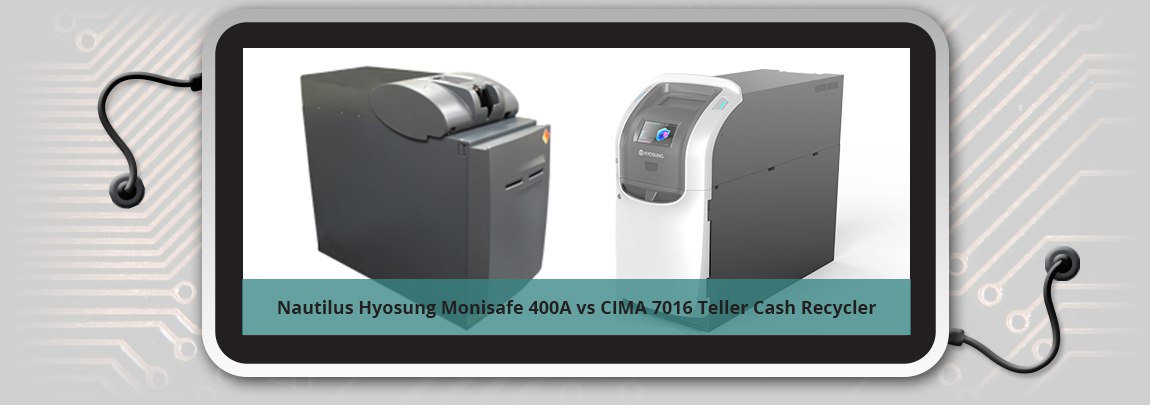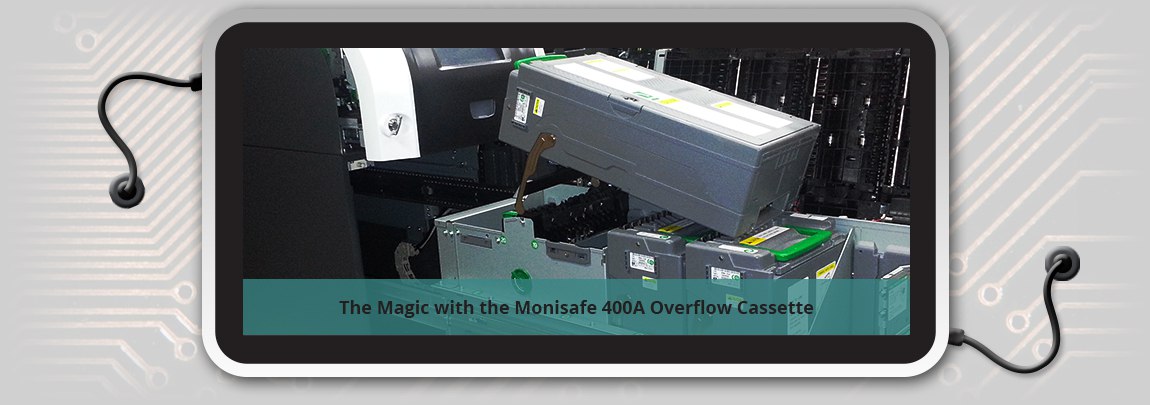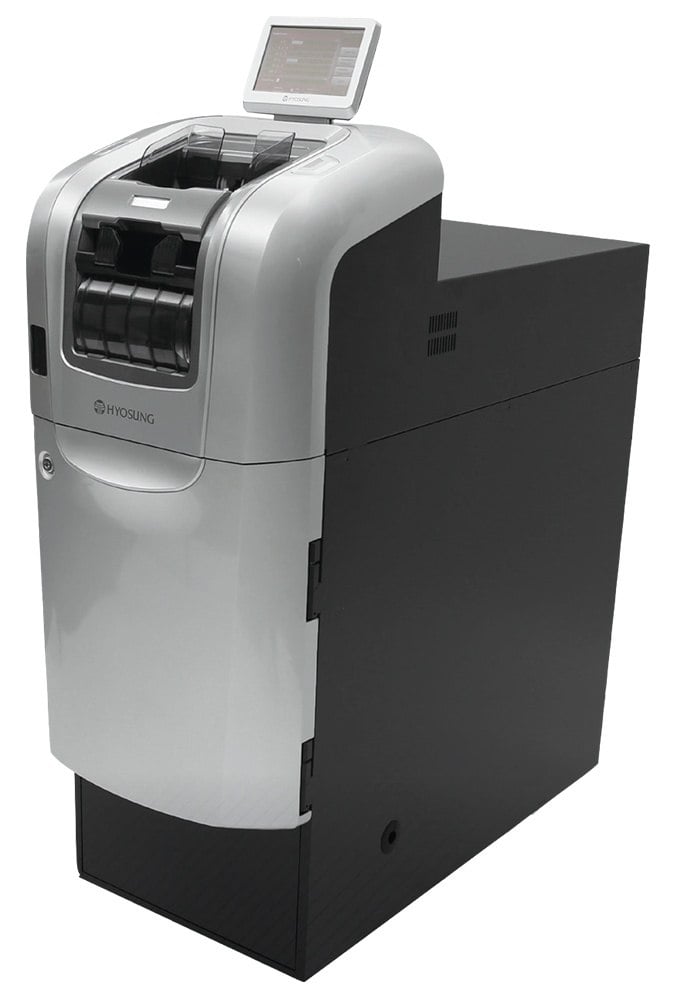The Magic with the Monisafe 400A Overflow Cassette
It’s probably better to name this cassette a universal cassette than an overflow cassette, but overflow is what Hyosung refers to it as, so we’ll...
5 min read
 Sean Farrell
:
Jan 5, 2015 8:29:00 AM
Sean Farrell
:
Jan 5, 2015 8:29:00 AM


In this article we talk about the Nautilus Hyosung MoniSafe 400A in comparison to the 16 drum CIMA 7016 teller cash recycler. Both of these units are larger capacity than is standard on the market, and each offer their own pros and cons. There has been a lot of market buzz surrounding the MoniSafe 400A based on the reputation that Nautilus Hyosung has built in the market as an innovator and a company that builds quality products. The CIMA brand name, may not be as widely known, even in the US market, as the Hyosung brand, but don’t be fooled it doesn’t back down from a challenge. QDS offers both of these these cash recyclers and we aim to give an honest review of each product so you can decide what makes the most sense for you.
The CIMA 7016 posts one of the largest recycling capacities in the market in total at 9600-11,200 notes depending on fitness. It accomplishes this through 16 RSMs (rolled storage modules), which allows the user to select up to 4 RSMs per denomination for storage. Since the CIMA unit has no physical escrow, all of the notes are stored as they are deposited giving the user a “virtual escrow” on deposit. The Monisafe 400A boasts a cassette based storage system made up of 7 storage cassettes. They break these 7 cassettes down into 2 large storage cassettes of 2500 notes each plus 4 smaller cassettes of 750 notes each and 1 other large overflow cassette of 2500 notes for excess storage and cash management. The overflow cassette provides some unique features that we will get into later in the article. From a pure recycling note capacity the CIMA 7016 offers about 20-30% more recycling capacity than the Monisafe 400A. If you are curious about the differences between RSM storage and Cassette storage check out this article Rolled Storage Module (RSM) versus Cassette Cash Recycler Storage.
An interesting subtitle for sure, right? I wanted to go over the visual appearance and measurements because that can be an important criteria in determining fit for your location. The CIMA 7016 is a large unit, but still fits under the standard counter at 37.75” tall. It is about 45” deep including the beauty door on the front and is 17.3” wide or about the size of under counter steel. The CIMA 7016 has no screen, just two arrows indicating who has control of the recycler and therefore who’s money has come out. The CIMA has a more industrial feel and lacks a little bit of the beauty factor that some of the newer models have. I would put the CIMA in the workhorse category though, as it performs day in day out with little frills. The Monisafe 400A has a great footprint. It’s less tall, so it can even fit under some older counters that weren’t 40” tall. It stands about 34.5” tall, roughly the same depth at 45” to the front of the beauty door, and roughly the same width at just over 17” wide. The Monisafe 400A posts a 7” LCD touchscreen that is used for inventory and other diagnostic features, which is a nice add in. The machine has a great modern design with white beauty doors and futuristic button lights that indicate who’s money is present. The Monisafe 400A also boasts a door that covers the input area which can prevent unwanted objects from falling into the recycler which happens more than most tellers would like to admit. Overall from a looks perspective the Monisafe is the winner here.
One of the key benefits of teller cash recyclers in the efficiency gain from speeding up transactions over the old manual process. Therefore the time it takes for the recycler to complete the transaction can make a big difference in the customer experience. The Monisafe 400A posts an input amount of 200 notes which is about 50-100 notes larger than most other recyclers can handle per batch inputting into the machine. The brochure boasts a speed of 8 notes per second both in an out, which is probably accurate. The only downside to the 400A is its 200 note physical escrow. Notes are taking from input into escrow at that 8 notes per second and then once the escrow is full, it has to move them from escrow into storage, which creates a two stage process. While it doesn’t require any user interaction, it does drop the overall input speed down to probably 3-4 notes per second. The CIMA 7016 on the other had has a continuous feed functionality that allows you to start with 150 notes and continually stack notes on as the machine is processing. This is different from most other recyclers where you run a batch and then add more cash after the machine opens back up and hit more to add cash to the deposit. The CIMA boasts 7-8 notes per second on deposit, making it one of the fastest machines on the market, and when you pair that with continuous feed it makes a tough combination to beat. On the outgoing side the Monisafe 400A can dispense up to a 200 note bundles, where the CIMA will only dispense in 100 note bundles. While it’s not often that more than 100 notes are needed, it is nice to have the ability to dispense batches of 200. Overall the CIMA 7016 processes large amounts of cash in much faster, while the Monisafe 400A is probably a bit quicker in giving cash out by maybe 1 note per second.
The Monisafe 400A has 2 unique qualities that both center around the overflow cassette. When any of the denomination cassettes are full, currency automatically “overflows” into the large cassette for storage. The unique feature that the MoniSafe 400A brings that others can’t do, is actually bring that currency back out for usage when the cassettes start to get back to low again. Therefore, if you maybe have an extra 300-500 $20s that have overflowed, when your 20s cassette gets back low again, you can move that money back into the recycle cassettes to be able to use it for transactions. Really cool! Secondly, the overflow cassette can be used to do an internal self-audit. What in the world is that you may be asking yourself. Well most recyclers you have the machine spit out all of the cash, count it with a note counter or discriminator to verify what the machine says it has in it, it actually does. Most people audit their recyclers now monthly or quarterly, because it is a rare occurrence that an audit should need to be performed. But, the Monisafe 400A can actually audit itself without the cash ever having to leave the machine, one cassette at a time. It moves notes 200 at a time back through the bill reader and compares the expected value of the audit versus what it recounts as its auditing. This process can take some time, but it doesn’t require dual control because the cash never leaves the safe. Pretty amazing!
For the CIMA 7016, the ability to have 16 drums and to be able to assign up to 4 to any denomination really allows each position in the branch to custom tailor their cash management needs to their customers. Sometimes the drive through needs a different mix of cash than the front line and you can make that happen. Also, by having 2 sets of 8 drums, should a service issue arise in one set, the machine can in some cases run off the 8 that don’t have an issue. This allows you to run on reduced capacity but keep your recycler running, which is a nice feature for sure.
Overall, the Monisafe 400A probably has some shinier bells and whistles. The 7” display, and overflow cassette features are really nice to have. On the other hand, the CIMA 7016 is a true workhorse when it comes to transaction efficiency. While the CIMA may not be the prettiest horse in the show, she can outperform just about anything in the market today in terms of cash processing. So the choice is yours: a new product from a great manufacturer that has some tremendous potential in the Monisafe 400A or a tried and true workhorse from CIMA with high capacity and input speed that will make your busiest of locations perform better. Ultimately either way you choose, it’s better than doing it manually.

It’s probably better to name this cassette a universal cassette than an overflow cassette, but overflow is what Hyosung refers to it as, so we’ll...

Hyosung's MS500 cash recycler really changed the game for cash automation and there are features of the MoniSafe 500 that are truly exciting for...

As a cash automation provider who carries both RSM based recyclers and cassette based recyclers, we often get asked which is better?It's a very...